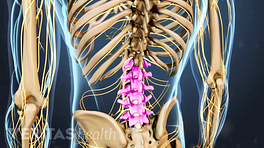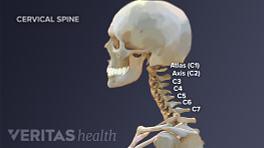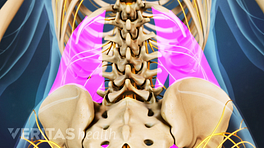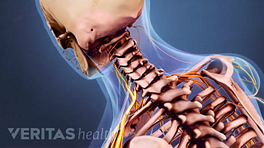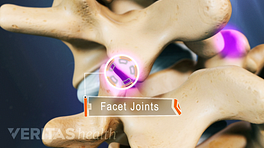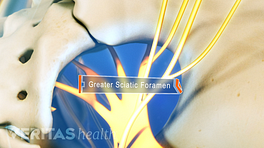The spine is an interconnected complex of bones, nerves, muscles, tendons, and ligaments, any of which can become damaged and cause pain, neurological symptoms, or loss of mobility.
The vertebrae are the bony building blocks of the spine.
There are seven cervical vertebrae in the neck, twelve thoracic vertebrae in the upper back, and five lumbar vertebrae in the lower back.
Each vertebral segment is comprised of a cylinder-shaped bone in the front of the spine, called the vertebral body, a soft cartilage disc between each vertebra, and paired facet joints in the back.
Each segment is named for its upper and lower vertebra, such as the C6-C7 segment.
The bones in the spinal column surround and protect the spinal cord, which runs behind the vertebral bodies in a canal from the neck down to the top of the lumbar spine.
In the lumbar spine the nerves branch out from the spinal canal and exit the spine in a pattern that resembles a horses tail, called the cauda equina.
At each segment, spinal nerve roots exit the spine through holes in the back of the vertebrae called foramen.
Any compression of the nerve root in the foraminal opening, which can occur due to bone spurs, herniated or degenerated discs, or facet joint problems, can cause pain and possible neurological symptoms to radiate along the path of the nerve. These symptoms are commonly called radiculopathy, and leg symptoms may also be called sciatica.
In between the vertebrae, the intervertebral discs serve as shock absorbers and help facilitate movement of the spine.
These discs can degenerate over time and become a source of pain, a condition called degenerative disc disease.
The soft inner core of the disc can extrude, called a herniated disc, and inflame a nearby nerve root. Pain radiates along the path of the affected nerve and into the arm or leg.
The sacrum connects the base of the spine with the pelvis at the sacroiliac joints. If these joints are too loose or too tight, it can cause lower back pain due to sacroiliac joint dysfunction.
Below the sacrum is the coccyx, or tailbone, which consists of several small bones. Any damage to this area can cause tailbone pain.
The entire spine is knit together by a series of interconnected ligaments and tendons that help support and stabilize the spine while allowing a great deal of flexibility.

